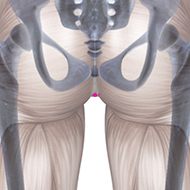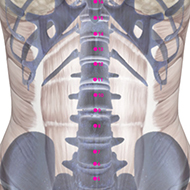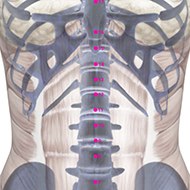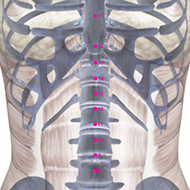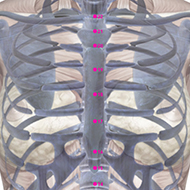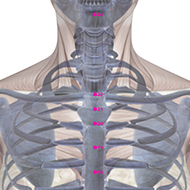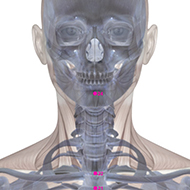The meridian system (simplified Chinese: 经络; traditional Chinese: 經絡; pinyin: jīngluò, also called channel network) is a concept in Traditional Chinese medicine (TCM) about a path through which the life-energy known as “qi” flows.1 The twelve standard meridians, also called principal meridians, are divided into Yin and Yang groups. The Yin meridians of the arm are Lung, Heart, and Pericardium. The Yang meridians of the arm are Large Intestine, Small Intestine, and Triple Burner. The Yin Meridians of the leg are Spleen, Kidney, and Liver. The Yang meridians of the leg are Stomach, Bladder, and Gall Bladder.2
The eight extraordinary meridians are of pivotal importance in the study of Qigong, T’ai chi ch’uan and Chinese alchemy.3 These eight extra meridians are different to the standard twelve organ meridians in that they are considered to be storage vessels or reservoirs of energy and are not associated directly with the Zang Fu, i.e. internal organs.
The eight extraordinary vessels are (奇經八脈; qí jīng bā mài):4
Conception Vessel (Ren Mai) – 任脈 [rèn mài], Governing Vessel (Du Mai) – 督脈 [dū mài], Penetrating Vessel (Chong Mai) – 衝脈 [chōng mài], Girdle Vessel (Dai Mai) – 帶脈 [dài mài], Yin linking vessel (Yin Wei Mai) – 陰維脈 [yīn wéi mài], Yang linking vessel (Yang Wei Mai) – 陽維脈 [yáng wéi mài], Yin Heel Vessel (Yin Qiao Mai) – 陰蹻脈 [yīn qiāo mài], Yang Heel Vessel (Yang Qiao Mai) – 陽蹻脈 [yáng qiāo mài].
In Traditional Chinese Medicine, Conception Vessel (CV) is one of the Eight Extra Meridians. Of the eight, Governor Vessel, Conception Vessel and Thoroughfare Vessel all originate in the uterus and emerge from the perineum and are therefore called three meridians sharing the same origin.
CV has a close relation with the six yin meridians (including Taiyin Lung Meridian of the Hand, Shaoyin Heart Meridian of the Hand, Jueyin Pericardium Meridian of the Hand, Taiyin Spleen Meridian of the Foot, Shaoyin Kidney Meridian of the Foot, Jueyin Liver Meridian of the Foot). It regulates the qi of the yin meridians of the whole body, therefore it is called the sea of the yin meridians.5
CONTENTS
ACUPOINTS
FLOWING ROUTES
ACUPOINTS
The Conception Vessel contains 24 acupoints.
CV-1
Location: Between the anus and the root of the scrotum in males and between the anus and the posterior labial commissure in females.
Indications: Vaginitis, retention of urine hemorrhoids, nocturnal emission, enuresis, irregular menstruation, mental disorders.
Acupuncture Method: Puncture perpendicularly 0.5-1.0 inch. Moxibustion is applicable.
Vasculature: The branches of the perineal artery and vein.
Innervation: The branch of the perineal nerve.
CV-2
Location: On the midpoint of the upper border of the symphysis pubis.
Indications: Retention and dribbling of urine, enuresis, nocturnal emission, impotence, morbid leukorrhea, irregular menstruation, dysmenorrhea, hernia.
Acupuncture Method: Puncture perpendicularly 0.5-1.0 inch. Great care should be taken to puncture the points from Qugu (CV-2) to Shangwan (CV-13) of this meridian in pregnant women. Moxibustion is applicable.
Vasculature: The branches of the inferior epigastric artery and the obturator artery.
Innervation: The branch of the iliohypogastric nerve.
CV-3
Location: On the anterior midline, 4 cun below the umbilicus.
Indications: Enuresis, nocturnal emission, impotence, hernia, uterine bleeding, irregular menstruation, dysmenorrhea, morbid leukorrhea, frequency of urination, retention of urine, pain in the lower abdomen, prolapse of the uterus, vaginitis.
Acupuncture Method: Puncture perpendicularly 0.5-1.0 inch. Moxibustion is applicable.
Vasculature: The branches of superficial epigastric artery and vein, and the branches of inferior epigastric artery and vem.
Innervation: The branch of the iliohypogastric nerve.
CV-4
Location: On the anterior midline, 3 cun below the umbilicus.
Indications: Enuresis, nocturnal emission, frequency of urination, retention of urine, hernia, irregular menstruation, morbid leukorrhea, dysmenorrhea, uterine bleeding, postpartum hemorrhage, lower abdominal pain, indigestion, diarrhea, prolapse of the rectum, flaccid type of apoplexy.
Acupuncture Method: Puncture perpendicularly 0.8-1.2 inches. This is one of the important points for tonification. Moxibustion is applicable.
Vasculature: See Zhongji (CV-3).
Innervation: The medial branch of the anterior cutaneous branch of the twelfth intercostal nerve.
CV-5
Location: On the anterior midline, 2 cun below the umbilicus.
Indications: Abdominal pain, diarrhea, edema, hernia, anuria, enuresis, amenorrhea, morbid leukorrhea, uterine bleeding, postpartum hemorrhage.
Acupuncture Method: Puncture perpendicularly 0.5-1.0 inch. Moxibustion is applicable.
Vasculature: See Zhongji (CV-3).
Innervation: The anterior cutaneous branch of the eleventh intercostal nerve.
CV-6
Location: On the anterior midline, 1.5 cun below the umbilicus.
Indications: Abdominal pain, enuresis, nocturnal emission, impotence, hernia, edema, diarrhea, dysentery, uterine bleeding, irregular menstruation, dysmenorrhea, amenorrhea, morbid leukorrhea, postpartum hemorrhage, constipation, flaccid type of apoplexy, asthma.
Acupuncture Method: Puncture perpendicularly 0.8-1.2 inches. This is one of the important points for tonification. Moxibustion is applicable.
Regional anatomy: See Shimen (CV-5).
CV-7
Location: On the anterior midline, 1 cun below the umbilicus.
Indications: Abdominal distention, edema, hernia, irregular menstruation,
uterine bleeding, morbid leukorrhea, pruritus vulvae, postpartum hemorrhage, abdominal pain around the umbilicus.
Acupuncture Method: Puncture perpendicularly 0.8-1.2 inches. Moxibustion is applicable.
Regional anatomy Vasculature: See Zhongji (CV-3).
Innervation: The anterior cutaneous branch of the tenth intercostal nerve.
CV-8
Location: In the centre of the umbilicus.
Indications: Abdominal pain, borborygmus, flaccid type of apoplexy, prolapse of the rectum, unchecked diarrhea.
Acupuncture Method: Puncture is prohibited. Moxibustion is applicable.
Vasculature: The inferior epigastric artery and vein.
Innervation: The anterior cutaneous branch of the tenth intercostal nerve.
CV-9
Location: On the anterior midline, 1 cun above the umbilicus.
Indications: Abdominal pain, borborygmus, edema, retention of the urine, diarrhea.
Acupuncture Method: Puncture perpendicularly 0.5-1.0 inch. Moxibustion is applicable.
Regional anatomy Vasculature: See Shenque (CV-8).
Innervation: The anterior cutaneous branch of the eighth and ninth intercostal nerves.
CV-10
Location: On the anterior midline, 2 cun above the umbilicus.
Indications: Epigastric pain, abdominal pain, borborygmus, indigestion, vomiting, diarrhea.
Acupuncture Method: Puncture perpendicularly 0.5-1.2 inches. Moxibustion is applicable.
Vasculature: See Shenque (CV-8).
Innervation: The anterior cutaneous branch of the eighth intercostal nerve.
CV-11
Location: On the anterior midline, 3 cun above the umbilicus.
Indications: Stomachache, vomiting, abdominal distention, borborygmus, edema, anorexia.
Acupuncture Method: Puncture perpendicularly 0.5-1.2 inches. Moxibustion is applicable.
Vasculature: The branches of the superior and inferior epigastric arteries.
Innervation: The anterior cutaneous branch of the eighth intercostal nerve.
CV-12
Location: On the anterior midline, 4 cun above the umbilicus.
Indications: Stomachache, abdominal distention, borborygmus, nausea, vomiting, acid regurgitation, diarrhea, dysentery, jaundice, indigestion, insomnia.
Acupuncture Method: Puncture perpendicularly 0.5-1.2 inches. Moxibustion is applicable.
Vasculature: The superior epigastric artery and vein.
Innervation: The anterior cutaneous branch of the seventh intercostal nerve.
CV-13
Location: On the anterior midline, 5 cun above the umbilicus.
Indications: Stomachache, abdominal distention, nausea, vomiting, epilepsy, insomma.
Acupuncture Method: Puncture perpendicularly 0.5-1.2 inches. Moxibustion is applicable.
Regional anatomy: See Zhongwan (CV-12).
CV-14
Location: On the anterior midline of the abdomen, 6 cun above the umbilicus.
Indications: Pain in the cardiac region and the chest, nausea, acid regurgitation, difficulty in swallowing, vomiting, mental disorders, epilepsy, palpitation.
Acupuncture Method: Puncture perpendicularly 0.3-0.8 inch. Moxibustion is applicable.
Regional anatomy: See Zhongwan (CV-12).
CV-15
Location: On the anterior midline, 1 cun below the xiphosternal synchondrosis. Locate the point in supine position with the arms uplifted.
Indications: Pain in the cardiac region and the chest, nausea, mental disorders, epilepsy.
Acupuncture Method: Puncture obliquely downward 0.4-0.6 inch. Moxibustion is applicable.
Regional anatomy: See Zhongwan (CV-12).
CV-16
Location: On the anterior midline, at the level with the 5th intercostal space, on the xiphosternal synchondrosis.
Indications: Distension and fullness in the chest and intercostal region, hiccup, nausea, anorexia.
Acupuncture Method: Puncture subcutaneously 0.3-0.5 inch. Moxibustion is applicable.
Vasculature: The anterior perforating branches of the internal mammary artery and vein.
Innervation: The medial branch of the anterior cutaneous branch of the sixth intercostal nerve.
CV-17
Location: On the anterior midline, at the level with the 4th intercostal space, midway between the nipples.
Indications: Asthma, pain in the chest, fullness in the chest, palpitation, insufficient lactation, hiccup, difficulty in swallowing.
Acupuncture Method: Puncture subcutaneously 0.3-0.5 inch. Moxibustion is applicable.
Vasculature: See Zhongting (CV-16).
Innervation: The anterior cutaneous branch of the fourth intercostal nerve.
CV-18
Location: On the anterior midline, at the level with the 3rd intercostal space.
Indications: pain in the chest, cough, asthma, vomiting.
Acupuncture Method: Puncture subcutaneously 0.3-0.5 inch. Moxibustion is applicable.
Vasculature: See Zhongting (CV-16).
Innervation: The anterior cutaneous branch of the third intercostal nerve.
CV-19
Location: On the anterior midline, at the level with the 2nd intercostal space.
Indications: Pain in the chest, asthma, cough.
Acupuncture Method: Puncture subcutaneously 0.3-0.5 inch. Moxibustion is applicable.
Vasculature: See Zhongting (CV-16).
Innervation: The anterior cutaneous branch of the second intercostal nerve.
CV-20
Location: On the anterior midline, at the midpoint of the sternal angle, at the level with the 1st intercostal space.
Indications: Pain and fullness in the chest and intercostal region, asthma, cough.
Acupuncture Method: Puncture subcutaneously 0.3-0.5 inch. Moxibustion is applicable.
Vasculature: See Zhongting (CV-16).
Innervation: The anterior cutaneous branch of the first intercostal nerve.
CV-21
Location: On the anterior midline, in the centre of the sternal manubrium, 1 cun below Tiantu (CV-22).
Indications: Pain in the chest, cough, asthma.
Acupuncture Method: Puncture subcutaneously 0.3-0.5 inch. Moxibustion is applicable.
Vasculature: See Zhongting (CV-16).
Innervation: The anterior branch of the supraclavicular nerve and the anterior cutaneous branch of the first intercostal nerve.
CV-22
Location: In the centre of the suprasternal fossa.
Indications: Asthma, cough, sore throat, dry throat, hiccup, sudden hoarseness of the voice, difficulty in swallowing, goiter.
Acupuncture Method: First puncture perpendicularly 0.2 inch and then insert the needle tip downward along the posterior aspect of the sternum 0.5-1.0 inch. Moxibustion is applicable.
Vasculature: Superficially, the jugular arch and the branch of the inferior thyroid artery; deeper, the trachea; inferiorly, at the posterior aspect of the sternum, the inominate vein at aortic arch.
Innervation: The anterior branch of the supraclavicular nerve.
CV-23
Location: Above the Adam’s apple, in the depression of the upper border of the hyoid bone.
Indications: Swel1ing and pain of the subglossal region, salivation with glossoplegia, aphasia with stiffness of tongue by apoplexy, sudden hoarseness of the voice, difficulty in swal1owing.
Acupuncture Method: Puncture obliquely 0.5-1.0 inch toward the tongue root. Moxibustion is applicable.
Vasculature: The anterior jugular vein.
Innervation: The branch of the cutaneous cervical nerve, the hypoglossal nerve, and the branch of the glossopharyngeal nerve.
CV-24
Location: In the depression in the centre of the mentolabial groove.
Indications: Facial puffiness, swel1ing of the gums, toothache, salivation, mental disorders, deviation of the eyes and mouth.
Acupuncture Method: Puncture obliquely upward 0.2-0.3 inch. Moxibustion is applicable.
Vasculature: The branches of the inferior labial artery and vein.
Innervation: The branch of the facial nerve.6
FLOWING ROUTES
It starts from the inside of the lower abdomen and comes out from the perineum. It goes anteriorly to the pubic region and ascends along the interior side of the abdomen, passes through Guanyuan (CV-4) and reaches the throat. Ascending further, it curves around the lips, passes through the cheek and enters the infraorbital region Chengqi (ST-1).7
Footnotes
- What Is Traditional Chinese Medicine – sciencebasedmedicine.org – 2012, https://sciencebasedmedicine.org/what-is-traditional-chinese-medicine/
- Advanced Pressure Point Fighting of Ryukyu Kempo – A Dillman Karate International Book – 1994, https://www.amazon.com/Advanced-Pressure-Point-Fighting-Ryukyu/dp/0963199633/
- T’ai Chi Ch’uan and Meditation – Library of Congress – 1991, https://www.amazon.com/TAi-Chi-ChUan-Meditation-Liu/dp/080520993X
- The foundations of chinese medicine: a comprehensive text for acupuncturists and herbalists – Black Dog & Elsevier Churchill Livingstone – 2005, https://www.amazon.com/Foundations-Chinese-Medicine-Comprehensive-Acupuncturists/dp/0443074895
- Conception Vessel Meridian – tcmwiki.com – 2017, https://tcmwiki.com/wiki/conception-vessel
- Acupuncture points of the CV meridian – cnacupuncture.com – 2017, http://www.cnacupuncture.com/points-of-ren-channel.html
- Conception Vessel Meridian – tcmwiki.com – 2017, https://tcmwiki.com/wiki/conception-vessel
LU01
LU02
LU03
LU04
LU05
LU06
LU07
LU08
LU09
LU10
LU11
LI01
LI02
LI03
LI04
LI05
LI06
LI07
LI08
LI09
LI10
LI11
LI12
LI13
LI14
LI15
LI16
LI17
LI18
LI19
LI20
ST01
ST02
ST03
ST04
ST05
ST06
ST07
ST08
ST09
ST10
ST11
ST12
ST13
ST14
ST15
ST16
ST17
ST18
ST19
ST20
ST21
ST22
ST23
ST24
ST25
ST26
ST27
ST28
ST29
ST30
ST31
ST32
ST33
ST34
ST35
ST36
ST37
ST38
ST39
ST40
ST41
ST42
ST43
ST44
ST45
SP01
SP02
SP03
SP04
SP05
SP06
SP07
SP08
SP09
SP10
SP11
SP12
SP13
SP14
SP15
SP16
SP17
SP18
SP19
SP20
SP21
HT01
HT02
HT03
HT04
HT05
HT06
HT07
HT08
HT09
SI01
SI02
SI03
SI04
SI05
SI06
SI07
SI08
SI09
SI10
SI11
SI12
SI13
SI14
SI15
SI16
SI17
SI18
SI19
BL01
BL02
BL03
BL04
BL05
BL06
BL07
BL08
BL09
BL10
BL11
BL12
BL13
BL14
BL15
BL16
BL17
BL18
BL19
BL20
BL21
BL22
BL23
BL24
BL25
BL26
BL27
BL28
BL29
BL30
BL31
BL32
BL33
BL34
BL35
BL36
BL37
BL38
BL39
BL40
BL41
BL42
BL43
BL44
BL45
BL46
BL47
BL48
BL49
BL50
BL51
BL52
BL53
BL54
BL55
BL56
BL57
BL58
BL59
BL60
BL61
BL62
BL63
BL64
BL65
BL66
BL67
KD01
KD02
KD03
KD04
KD05
KD06
KD07
KD08
KD09
KD10
KD11
KD12
KD13
KD14
KD15
KD16
KD17
KD18
KD19
KD20
KD21
KD22
KD23
KD24
KD25
KD26
KD27
PC01
PC02
PC03
PC04
PC05
PC06
PC07
PC08
PC09
TB01
TB02
TB03
TB04
TB05
TB06
TB07
TB08
TB09
TB10
TB11
TB12
TB13
TB14
TB15
TB16
TB17
TB18
TB19
TB20
TB21
TB22
TB23
GB01
GB02
GB03
GB04
GB05
GB06
GB07
GB08
GB09
GB10
GB11
GB12
GB13
GB14
GB15
GB16
GB17
GB18
GB19
GB20
GB21
GB22
GB23
GB24
GB25
GB26
GB27
GB28
GB29
GB30
GB31
GB32
GB33
GB34
GB35
GB36
GB37
GB38
GB39
GB40
GB41
GB42
GB43
GB44
LV01
LV02
LV03
LV04
LV05
LV06
LV07
LV08
LV09
LV10
LV11
LV12
LV13
LV14
GV01
GV02
GV03
GV04
GV05
GV06
GV07
GV08
GV09
GV10
GV11
GV12
GV13
GV14
GV15
GV16
GV17
GV18
GV19
GV20
GV21
GV22
GV23
GV24
GV25
GV26
GV27
GV28
CV01
CV02
CV03
CV04
CV05
CV06
CV07
CV08
CV09
CV10
CV11
CV12
CV13
CV14
CV15
CV16
CV17
CV18
CV19
CV20
CV21
CV22
CV23
CV24



